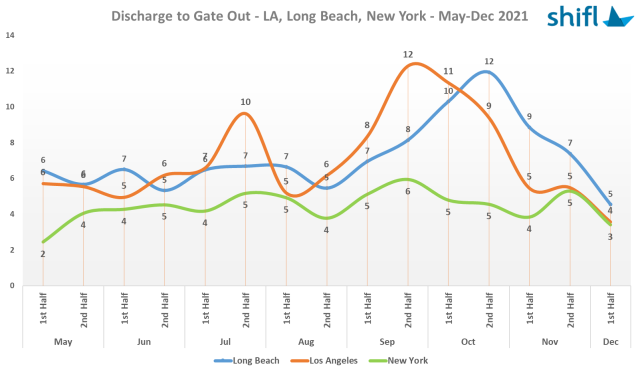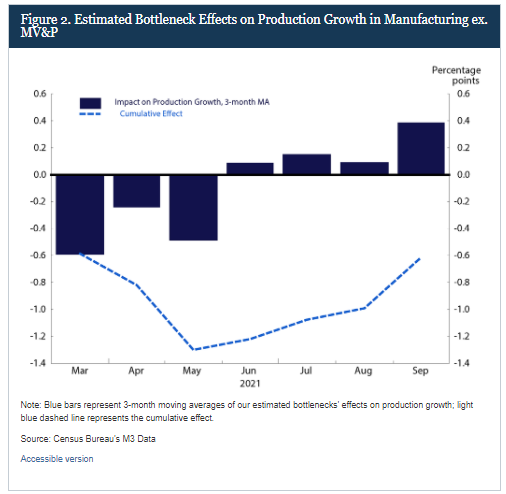Months of Coordination Bring Signs of Good Cheer
Significant Supply Chain Progress as the Holidays Draw Near
As we head into the homestretch of the holiday shopping season, we are providing our last update of the White House’s supply chain tracker before Christmas.
This month’s numbers
Today’s dashboard shows that the Ports of Los Angeles and Long Beach imported over 765,000 containers in November and more than 9.3 million containers so far this year—this is 15 percent more than they imported over the same period in 2018 (the previous record holder) and in fact more than they imported in all of 2018.

To help restore fluidity to the ports, the Biden-Harris Administration has worked with the Ports of Los Angeles and Long Beach to impose a fee on ocean carriers for containers that sit on the docks for more than eight days. This has helped reduce the number of long-dwelling containers sitting on the docks by almost 50 percent since the beginning of November.
There is promising evidence that containers are exiting the port more quickly. The digital freight forwarder Shifl released data showing the average amount of time containers sit on the docks in early December has fallen by about a week at each port since their respective peaks in the fall. The docks are increasingly no longer being used as warehousing space with the share of containers at the Port of Los Angeles that have been on the docks for 4 days or less rising from 38 percent to over 50 percent. Although the fee continues to be postponed by the ports, Shifl notes “the warning seems to have served well for hauling long overdue containers out of the port.”

Last month, the shipping industry implemented a new system for queuing ships outside of the Ports of Los Angeles and Long Beach to reduce congestion and the environmental impact of the ships on the communities living near the ports. Under this new system, ships remain 150 miles away from the California coast as they wait for a place to dock. Fewer visible ships does not mean the backlog has been resolved, as Secretary Buttigieg pointed out in November while this change was taking effect. We therefore continue to track delays while ships are at anchor right outside the port or delayed en route. In doing so, we see the number of ships ultimately waiting to dock continues to grow.
The amount of time it takes for a ship to dock after leaving a port in Asia has increased by about a week according to Shifl’s data, but this has been offset by the week-long reduction in the average number of days a container sits on the docks at the two ports. The end result is that the ports have managed to maintain the velocity of the goods movement system at the height of the shipping season despite an unprecedented demand for goods.
The holiday season sales outlook remains strong. November retail sales were up 9 percent in real terms compared to last year and the National Retail Federation recently revised upward its forecast of holiday shopping. Despite this historic demand for goods—which is a result of a shift by consumers from spending on services to goods due to the pandemic—retailers are successfully keeping their shelves stocked. At the end of October, retail inventories excluding autos were higher than they were before the pandemic and, as of December 12, 90 percent of goods in grocery and drug stores were in stock compared to 91 percent before the pandemic according to IRI.
More work ahead at the ports
In our last post we applauded the work of the world’ fourth largest ocean carrier, CMA CGM, to implement a new financial incentive that paid customers $100 to remove containers quickly and $200 for removing them during nights and weekends to incentivize off-peak operations. We asked other ocean carriers to follow their lead. We now have another ocean carrier doing just that: ZIM Integrated Shipping Services announced that it will pay $200 directly to truck drivers for picking up containers that have been on the docks for four days or less.
With historic profits, there is more ocean carriers can do to support both imports and exports. That is why we applaud the House of Representative for passing the Ocean Shipping Reform Act last week by an overwhelming, bipartisan margin of 364 to 60. As we noted in a previous blog, this an important first step to fixing a shipping system that is clearly not working as well as it should. Reinforcing the need for reform, Secretary Buttigieg of the Department of Transportation and Secretary Vilsack of the USDA sent a letter today to all of the ocean carriers strongly urging carriers to expand their use of other West Coasts ports, particularly the Port of Oakland, to support agricultural exports, and they suggested further action by the Federal Maritime Commission may be warranted to support fair treatment of exporters.
We will continue implementing our Port Action Plan, which accelerates investments in our ports, waterways, and freight networks after the passage of the Bipartisan Infrastructure Deal. Last month, the Administration provided the Port of Savannah flexibility to reallocate more than $8 million in federal funds to set up container yards in Georgia and North Carolina, freeing up dock space and speeding up the flow of goods in and out of the nation’s fourth largest port. Three container sites have now been stood up and are open for business in Savannah, Statesboro, and Atlanta, serving a variety of businesses from Home Depot and Carters to agricultural exporters. The number of container ships at anchor outside of Savannah has been cut by about two-thirds since the beginning of November.
Last week, the Department of Transportation awarded $12.6 million in grants to nine marine highway projects across the country under America’s Marine Highway Program. This funding will help address supply chain disruptions and congestion, easing the movement of goods along our navigable waterways while helping our ag exporters get goods to market. And this week, the Department announced over $50 billion in federal highway funding, much of which can be used to repair and modernize existing infrastructure to improve the performance of freight corridors.
Promising Signs in Manufacturing
There are some promising signs that manufacturers are seeing relief in supply chain disruption. The Institute of Supply Management’s Purchasing Managers Index is a survey of manufacturing supply executives and showed that more manufacturing firms reported expansion than contraction for the 18th consecutive month. It also showed in November that the share of firms reporting lengthening delivery times fell after growing in September and October. Similarly, the share of firms reporting growing backlogs and higher raw material prices also fell. The report concluded that “inputs — expressed as supplier deliveries, inventories, and imports — continued to constrain production expansion, but there are early signs of supplier performance improving.” Similarly, a Federal Reserve study in November shows that the effects of bottlenecks on manufacturing production growth—as calibrated by measured of unfilled orders and inventories relative to shipments excluding autos—peaked in May and showed steady improvement through September.

Launching the Trucking Action Plan
Over 70 percent of goods in America are shipped by truck, and in most communities, trucks are the only form of delivery. The pandemic exacerbated longstanding challenges in the trucking industry, including high turnover rates, an aging workforce, long hours away from home, and time spent waiting unpaid at congested loading areas. Long-haul full-truckload drivers only spend an average of 6.5 hours per working day driving despite being allowed to drive a maximum of 11 hours. That means about 40 percent of their capacity is not being used.
That is why the Supply Chain Disruptions Task Force continued to host meetings with the trucking industry about actions we could take to increase trucking capacity in our supply chains.
Yesterday, we announced our new Trucking Action Plan to strengthen America’s trucking workforce, building upon all we learned from talking to drivers, trucking companies, labor leaders, cargo owners, and others. The Action Plan cuts red tape so it’s easier for drivers to get commercial drivers licenses, which had been delayed by the pandemic, with over $30 million to help states upgrade their processing systems as well as technical assistance to speed up issuances. It also kicks off a 90-day Challenge to expand Registered Apprenticeships, a gold standard of workforce training to help develop and retain a skilled and safe workforce, with the Department of Labor helping companies launch them in as little as 48 hours. And we are taking additional steps to step up the recruitment of veterans while also launching a joint DOL-DOT Driving Good Jobs Initiative that will encourage underrepresented groups, like women and young drivers, to enter the profession and address the issues hurting retention of drivers like unpaid wait time and predatory truck leases.
Giving Thanks to Our Transportation Supply Chain Workers
The nation’s transportation workers—longshore, warehouse, trucking, rail, and more—have had a historic year as they helped the country move more goods than it ever has before. The pandemic reminded us all of how we all depend on the men and women in this industry to keep our shelves stocked and our businesses running. While there remains more work ahead to continue to meet the unprecedented demand and clear the congestion, we hope that they will also get some much deserved rest and time with their families this holiday season.

